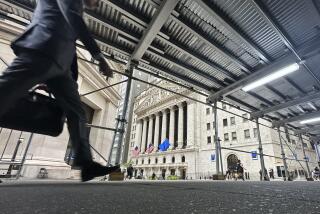Stocks fluctuate on details of housing plan
After flirting with a new bear-market low for a second day Wednesday, the Dow Jones industrials again showed a little resilience when it counted.
The 30-stock average finished up 3.03 points at 7,555.63, the index’s second straight finish only marginally above its 2008 closing low of 7,552.29 reached Nov. 20.
The market overall was broadly lower Wednesday as President Obama unveiled his $75-billion mortgage-rescue plan, although most major indexes remained comfortably above their November lows.
The Standard & Poor’s 500 eased 0.75 of a point, or 0.1%, to 788.42, leaving it 4.8% higher than its 2008 closing low of 752.44 set Nov. 20.
The Nasdaq composite fell 2.69 points to 1,467.97. It is 12% above its November nadir.
After Tuesday’s dive, the market was mostly stuck in neutral Wednesday. The Dow dipped as low as 7,480, then meandered around the 2008 closing low for much of the session.
As long as the major stock indexes hold above their 2008 lows, Wall Street can cling to hopes that the bear market isn’t about to begin a devastating new down leg that could drive more buy-and-hold investors away for good.
Market bulls may have been encouraged Wednesday that Obama’s plan to stem home foreclosures at least didn’t spook investors the way that Treasury Secretary Timothy F. Geithner’s detail-light bank-rescue plan did Feb. 10, when the Dow plummeted 4.6%.
But Obama’s program obviously didn’t excite investors either. And many analysts still see plenty to be worried about with the Dow so close to last year’s trough and with the economic news unrelentingly grim.
“It’s kind of troubling when you consider that we hit a new low in November -- and then the government realized the severity of the economic problems and has with each passing month tried to bring on a greater solution -- and yet despite all of that the market is essentially back where it was in November,” said Joe Battipaglia, market strategist in the private-client group at brokerage Stifel, Nicolaus & Co.
Sam Stovall, chief investment strategist at Standard & Poor’s, told clients Wednesday that “we think there is a good chance that a new bear-market low will be seen.”
Bear-market bottoms, he said in a note, “are typically volatile affairs, nothing like the relative calm we have seen lately. We believe a break below the November lows [would] open the door for another leg lower in the S&P; 500 to the 625 to 675 range.”
A drop to 625 would be a 21% decline from its current level.
In other market highlights Wednesday:
Shares of smaller companies fell more sharply than stocks of larger firms. The Russell 2,000 small-cap index of smaller companies fell 1.3%.
Declining issues outnumbered advancers by about 5 to 2 on the New York Stock Exchange.
Treasury bond yields rose after sliding along with stocks Tuesday. The benchmark 10-year T-note rose to 2.72% from 2.65% late Tuesday. The dollar was mixed against other major currencies.
Gold continued its approach toward the $1,000-an-ounce level. Near-term gold futures climbed $10.70 to $977.70.
Oil prices fell for the seventh time in eight sessions. Crude futures dropped 31 cents to $34.62 a barrel on the New York Mercantile Exchange.
Shares of Goodyear Tire & Rubber jumped 6% after the No. 1 U.S. tire maker said it would eliminate nearly 5,000 jobs this year.
Comcast slumped 4.1%. The country’s largest cable-TV provider said its earnings fell 32% in the latest quarter after a $600-million write-down.
Deere lost 3.8% after the maker of farm machinery posted a 45% slide in profit and slashed its 2009 earnings forecast.
Overseas, key stock indexes fell 0.7% in Britain, 0.3% in Germany and 1.5% in Japan. Shares in France inched lower.
--
tom.petruno@latimes.com
More to Read
Inside the business of entertainment
The Wide Shot brings you news, analysis and insights on everything from streaming wars to production — and what it all means for the future.
You may occasionally receive promotional content from the Los Angeles Times.










